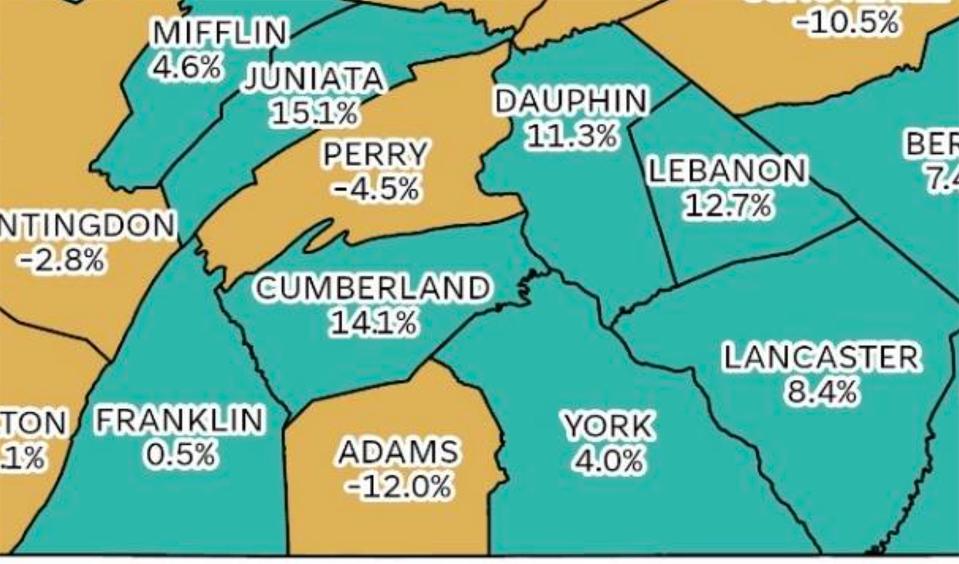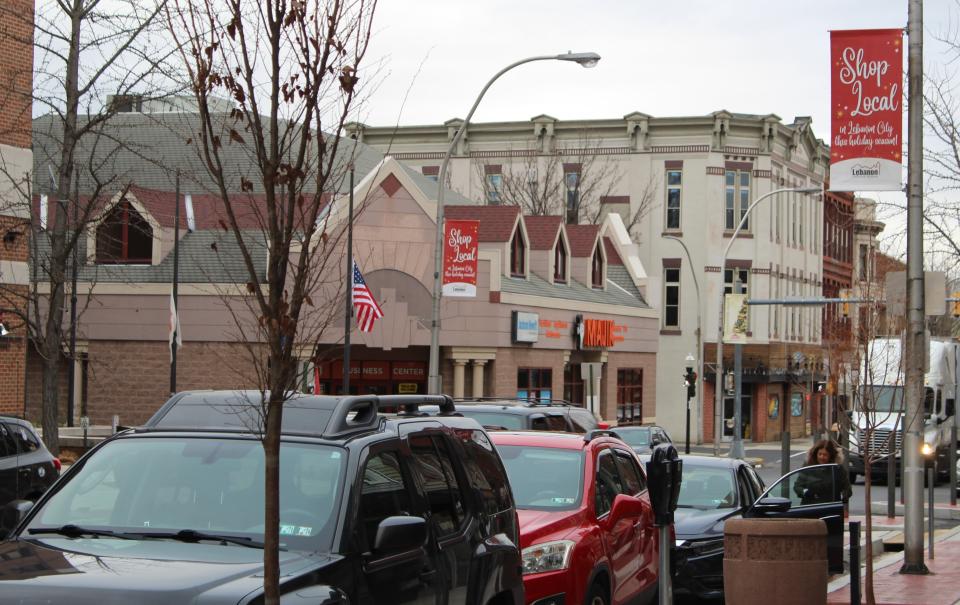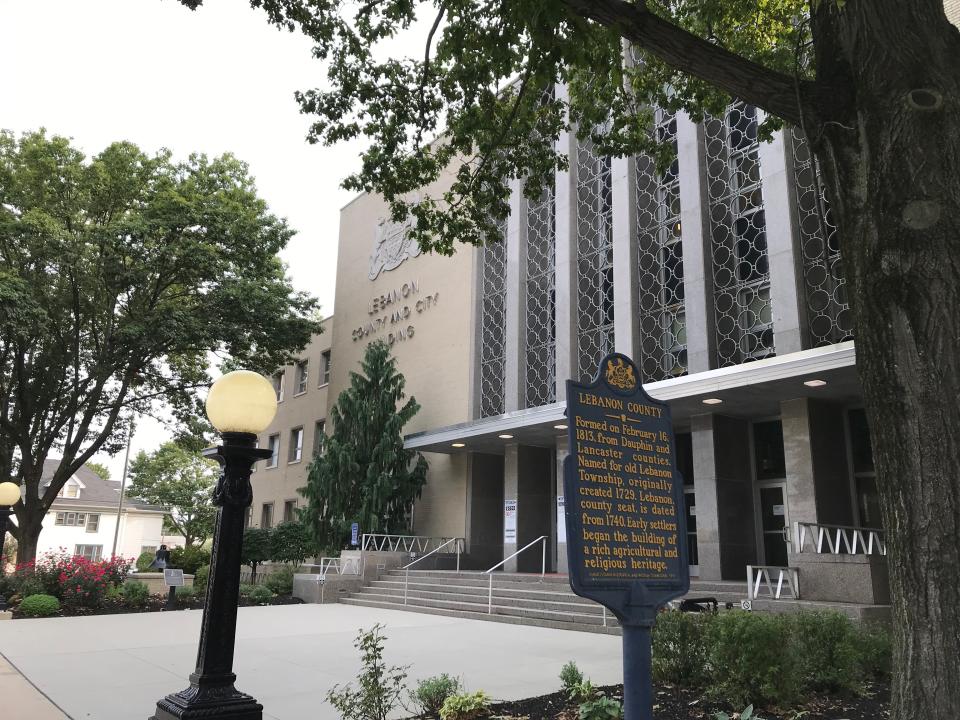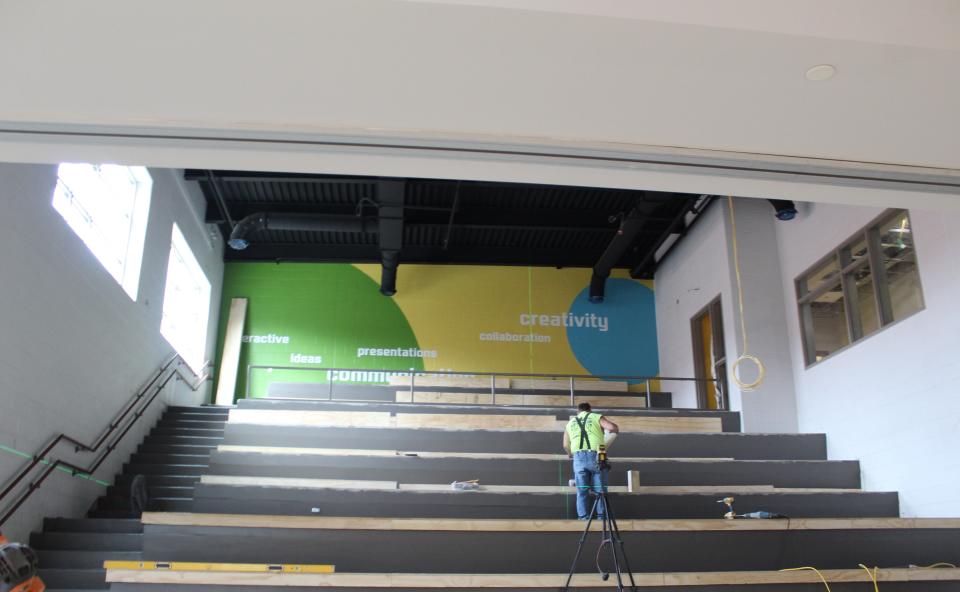Lebanon County is projected to grow 12.7% by 2050. Here's what that means for you
Lebanon County is expected to see a significant rise in population, according to a report by the Center for Rural Pennsylvania on state population projections through 2050.
According to the report, the population in rural Pennsylvania counties is expected to shrink by 5.8% overall, with the projected total growth rate for the state over the next 30 years to be 1.6%. Lebanon County is expected to see a 12.7% growth through 2025.
At the beginning of 2020, Lebanon County had a population of 143,282. Officials agree that if the projections are correct, the county could see a population of over 161,410 by 2025.

Officials said that population growth in the commonwealth has been largely driven by urban counties in the southeastern part of the state, like Lebanon. However, counties farther north and west are more likely to experience population decline over the next 30 years.
One of the biggest drivers of the population changes is the increased age of residents over the next 30 years.
"As the Baby Boomer generation continues to retire and age, the population of residents over 65 is going to sharply increase," according to the report. "This trend, contrasted with declining statewide birth rates, means that rural Pennsylvanians over the age of 65 will soon outnumber those under 20."
Here's what these changes could mean for Lebanon County residents:
Business
When considering this kind of projected growth in the business sector, Lebanon Valley Chamber of Commerce President Karen Groh said that one of the most important things to consider is the kinds of industry that the county invites.
“Honestly, I don’t think people are planning ahead that far. When I see that kind of growth projected, I think, boy, we’re in a hot mess now in terms of lack of housing and lack of higher-paying jobs,” Groh said. “So how are we going to accommodate?”
In a state of the county address in late May, Groh showed that job opportunities requiring high school education or lower far outweighed jobs requiring associates or graduate degrees. Jobs requiring bachelors degrees outpace the population in Lebanon at that education level.
An employer that provides higher-paying jobs requiring higher education or a higher level of skills would likely inform population growth, attracting higher educated and higher paid citizens, leveling out the current disparity and benefiting the local economy overall.
Attracting people early or in the middle of a career, Groh explained, would expand the arts and cultural activities in the county.
As industry, arts and culture flourish, a younger demographic that can continue to push forth greater growth in those areas will become more attracted to the area, Groh said, but reiterated that the process starts with businesses defining the kind of employee they want to hire.
“If you’re a township supervisor, if you’re an investor, if you’re a developer, there are appealing industries that we would love to have developed in Lebanon County. And frankly, Pennsylvania says the same thing; there are these top industries that they want to attract that are better for our economy.”
Groh pointed to the Pennsylvania Department of Community & Economic Development top industries list, which includes industries such as advanced manufacturing, life sciences and medical technology, and energy production and transportation as the kinds of businesses that would be the best for the local economy.

Over the last decade, transportation and warehousing have been the fastest-growing industry in the county, with a 46% net increase in the number of jobs in that sector over the last 10 years.
The growth of that industry can also be described through the 22 million square feet of warehouses on 2,150 acres of land throughout the county described by Lebanon Valley Economic Development Corporation President Susan Eberly during the state of the county address.
What kinds of businesses come to the county will likely depend on decisions made by municipalities, Groh said, and she hopes that instead of municipalities accepting whatever is put in front of them, conversations will be had, likely guided by the county's incoming comprehensive plan, about what is mutually beneficial for all parties.
Another piece of the puzzle for Groh is where to put this additional population, considering the county's already limited stock of housing − outlined in the recent housing study commissioned by the Coalition to End Homelessness, which described a less than 1% availability across all types of housing with a need for units in all affordability ranges.
State of the County: Lebanon County by the numbers: It's growing, jobs are plentiful, but health is an issue
Housing and social services
Between 2010 and 2022, households increased by 8% in Lebanon County, according to a study conducted by the Lebanon County Coalition to End Homelessness. That growth was already expected to increase by another 1%, or an additional 580 households, by 2027.
That growth is expected mostly with the 35-44 and Baby Boomer generation age groups, while younger generations and those in age groups between 45-64 are expected to leave the county.
County officials over the past few years have already seen greater demand for housing and social services from Lebanon residents. County Administrator Jamie Wolgemuth said officials weren't surprised about the need for housing in the area, given the changes in property values over the last few years.
"It is hard for someone in their 20s and even 30s to afford even a starter home these days," he said. "In Lebanon County, the average house is about $270,000, and even a starter home is often north of $200,000."
Housing study: Lebanon County is in dire need of housing. New study paints a stark picture
Across Lebanon County, 27% of households have at least one person employed, yet struggle to afford basic necessities, including housing, utilities, food, child care and health care, according to the Asset Limited Income Constrained, Employed, or ALICE, report. ALICE records household incomes that exceed the federal poverty level but are not high enough to pay for basic needs.
The City of Lebanon, Annville Township, Myerstown and Palmyra were identified by the ALICE report as having more than 40% of households not having incomes to pay for basic needs.
In 2021, more than 4,300 Lebanon County residents reached out to the United Way's 211 program. It connects families to local programs to help them financial, housing and food assistance.

The county has seen an increase in demand and expenses with social services such as Children and Youth and mental health. In October, Children and Youth Services reported that the final department costs for the 2022-23 fiscal year were at $12.9 million, which increased by almost $1.8 million. CYS was certified at $11.1 million for the 2022-23 fiscal year.
Officials said the increases were due to increased placement and in-home costs, CYS salary increases and more in-home service increases.
Officials have seen a decrease of people incarcerated at the Lebanon County Correctional Facility. The inmate population was over 400 during January 2020, but Wolgemuth said the population has since decreased to an average 275 in 2023.
"Now part of that was the pandemic, and an effort to avoid incarceration by the courts and some others during the height of the pandemic," Wolgemuth said. "But it has not rebounded."
ALICE report: Above poverty, but below basic needs: Data shows Lebanon residents struggle to avoid 'financial ruin'
The county has already seen a steady rise in it's Hispanic population over the last several years. According to population estimates in July 2023 by the U.S. Census Bureau, the Hispanic community makes up almost 44% of the City of Lebanon's population.
The trend toward a more diverse population is something county officials expect will continue in the future, according to Wolgemuth.
"We certainly have seen it as a county government," he said. "We have seen it in terms of having to employ a lot more translator s... and translating our documents. The (election) ballots have been for a long time. But the court system and the human services system needs translators, so I think that's indicative of an ever-growing, more diverse population."
Schools and education
Many Lebanon County school districts have looked at population growth predictions, but not as far in the future as the year 2050.
Supt. Philip Domencic said in an email that the Cornwall-Lebanon School District conducts annual enrollment projection studies and has found them to be very accurate in a 5- to 10-year timeframe. If there were to be a 12.7% increase in Cornwall-Lebanon School District’s population in the year 2050, Domencic noted, it would represent approximately 650 additional students across all grade levels.
The district's facilities, which are currently undergoing a construction project for renovations and a new connector building between the high school and middle school, allow for multiple contingencies, said Domencic. But he added it's important to remain flexible when meeting the educational and facility needs for students.
Comprehensive plan: Lebanon County municipal officials provide input ahead of new comprehensive plan
All districts in the county are currently undergoing, just finishing up, or starting the first steps of major construction or renovation projects on their facilities.
Eastern Lebanon County School District unveiled its new high school wing in November 2023, housing its agriculture, metal shop and wood shop, with continued renovations planned throughout. Northern Lebanon School District opened its new elementary school in August 2023.
Northern Lebanon Supt. Gary Messinger said that while the district is aware of projections as far out as 2050, there are too many variables for them to make long-term plans that far into the future. He added that because of the upgrades being made now, the school district will be in a financial position for further upgrades in the future if that need arises.

“If we had done no construction or renovation, we would have had difficulty with any increases in enrollment,” he said.
For many of the school districts, the need for additional staff to handle this kind of growth is a possibility. Messinger said that with the current teacher shortage, any increase in enrollment is a concern, but it’s possible that teacher availability would look different 10 to 20 years down the road.
ELCO Supt. Julia Vicente also said that population projections made this far in advance are subject to unforeseen circumstances, with five- to 10-year projections being better for planning purposes. She added that it was important to keep in mind that any kind of growth would be spread across the county and by age groups.
“If there is an increase in student enrollment, the district will analyze the data to make informed decisions regarding staffing to ensure that student-to-teacher ratios and resource allocation remain appropriate,” said ELCO Supt. Julia Vicente in an email. “Moreover, if there is significant enrollment growth, the district may need to make facility decisions to provide sufficient space for instruction and activities in our buildings.”
Children and Youth: Rising provider costs, lack of foster homes cause increased Lebanon County CYS expenses
In 2020, Annville-Cleona School District wrapped up additions to Cleona Elementary that added six classrooms. The district is currently in the middle of an addition and renovation project on the secondary school campus that will expand the cafeteria, add two additional classroom spaces and a large instruction area that can be converted into additional classrooms, among other renovations.
Annville Cleona Supt. Krista Antonis said that they’re also planning to put a larger addition onto Cleona Elementary School in order to free up space at Annville Elementary School and ensure the district is ready for additional students.
Palmyra Area School District is in the midst of a feasibility study through RLPS Architects and looking into possible construction options for the school. District officials have said the current buildings are almost at capacity.
According to district Palmyra Area School District Supt. Bernie Kepler, an updated enrollment study conducted by the Pennsylvania Economy League in 2022 shows a slight decline in enrollment in the district through 2025-2026, and stabilization at that point through 2032.
Palmyra School District: Palmyra school board looks to address growth, updating buildings with feasibility study
“With this said, population growth is something the district does consider and has been a topic at Palmyra Area School District for more than two decades given the growth the community has experienced,” Kepler wrote in an email. “Through the process of conducting an enrollment study, combined with our feasibility study, we have begun to engage our community to make decisions over the next several years on how to best anticipate potential growth and make determinations considering growth and financial considerations.”
Residents can see a copy of the Center for Rural Pennsylvania's population projections for 2050 at rural.pa.gov.
Matthew Toth is a reporter for the Lebanon Daily News. Reach him at mtoth@ldnews.com or on X at @DAMattToth.
Daniel Larlham Jr. is a reporter for the Lebanon Daily News. Reach him atDLarlham@LDNews.com or on X @djlarlham.
Northern Lebanon School District: Northern Lebanon's new elementary built with the future in mind
This article originally appeared on Lebanon Daily News: Lebanon County, Pa. projected to grow 12.7% by 2050. What that means

